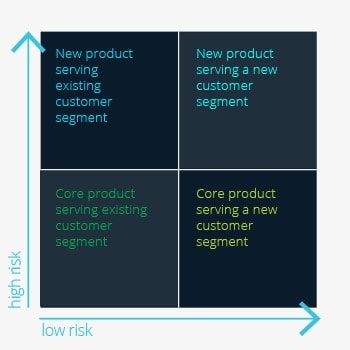At its core, a start-up is a small company trying to scale. Early on, innovation is the result of continuous ideation and quickly pivoting to market changes. But as start-ups grow into large companies, flexibility is replaced by stringent product management processes that account for every detail. As a result, the company’s entrepreneurial mindset and innovation can dissipate. But it doesn’t have to. In fact, it’s more important than ever that large companies embody the spirit of start-up innovation in their product development processes.
Identify and nurture your most innovative products
A 10,000-employee enterprise will never be as nimble or as flexible as a four-person start-up. Still, there are lessons to be learned from smaller organizations that keep product portfolios relevant and innovative. One mistake is to approach all types of innovation as the same. Many companies have a set of processes and treat something like “new to the world” as a label associated with the product concept. Successful leaders fund certain types of innovation differently, bringing in startup types of concepts and processes where it makes the most sense.
There are any number of ways to identify which products would be the most transformational, but a simple 2x2 quadrant is one of the best ways to visualize it:

The “new-new” products in the top-right quadrant have greater risks, but they stand to net the most impressive returns. These are the more transformational products, and they should be treated differently. The processes to these products forward require a hybrid product management approach we like to call structured flexibility.
This approach combines prescribed tasks in each stage of development with a more malleable, start-up mindset. There are more unknowns related to products in the top right quadrant, so the tasks that are traditionally necessary to move the development forward may not make sense for these products. Product managers must be open to looking at what tasks should be eliminated or updated and explore new action items that will push the product to the next stage.
Having a more flexible approach allows teams to overcome unexpected challenges, which are common in new product development. There’s no roadmap for new products, so it’s critical to keep a close eye on emerging challenges and quickly adjust. Applying a “what we’ve always done” mentality won’t solve the problem, and in many cases, it will make it worse. Instead of hitting a bump in the road and continuing on, you spend time reevaluating and remaking previous decisions, resulting in a delayed time-to-market.
Rethink product management for existing products, too
A start-up mentality doesn’t just make sense for the new-new product development—it’s also a great way to mine innovative ideas in core offerings. When a product is successful over a long period of time there’s understandable fear in disrupting success. There are plenty of examples of failed product enhancements.
But keep in mind that innovation to existing products doesn’t necessarily mean wholesale changes. It could mean a slight adjustment in the user experience or a new feature that integrates with emerging technology. Take smart products, for example. By adding connectivity to everything from cars to thermostats to refrigerators, the experience and usability of decades-old products have been completely reimagined.
And sometimes, that light bulb moment can lead to an entirely new product altogether. In short, constantly questioning traditional ways of thinking will bring to light new ideas that may have otherwise remained buried.
For larger companies, change can be difficult and a little unnerving. But those that reexamine the status quo and empower teams to embody a start-up spirit, especially for new-new transformational products, will be positioned to maintain market dominance with consistent innovation and enhanced core offerings that initiate market trends—instead of following them.
Learn more by listening to the Innovation+Talks podcast.
Business leaders can steer product and brand portfolios toward greater short- and long-term strategic success in meeting goals by incorporating these four strategies. Read four ways executives can accelerate innovation and new product development.








